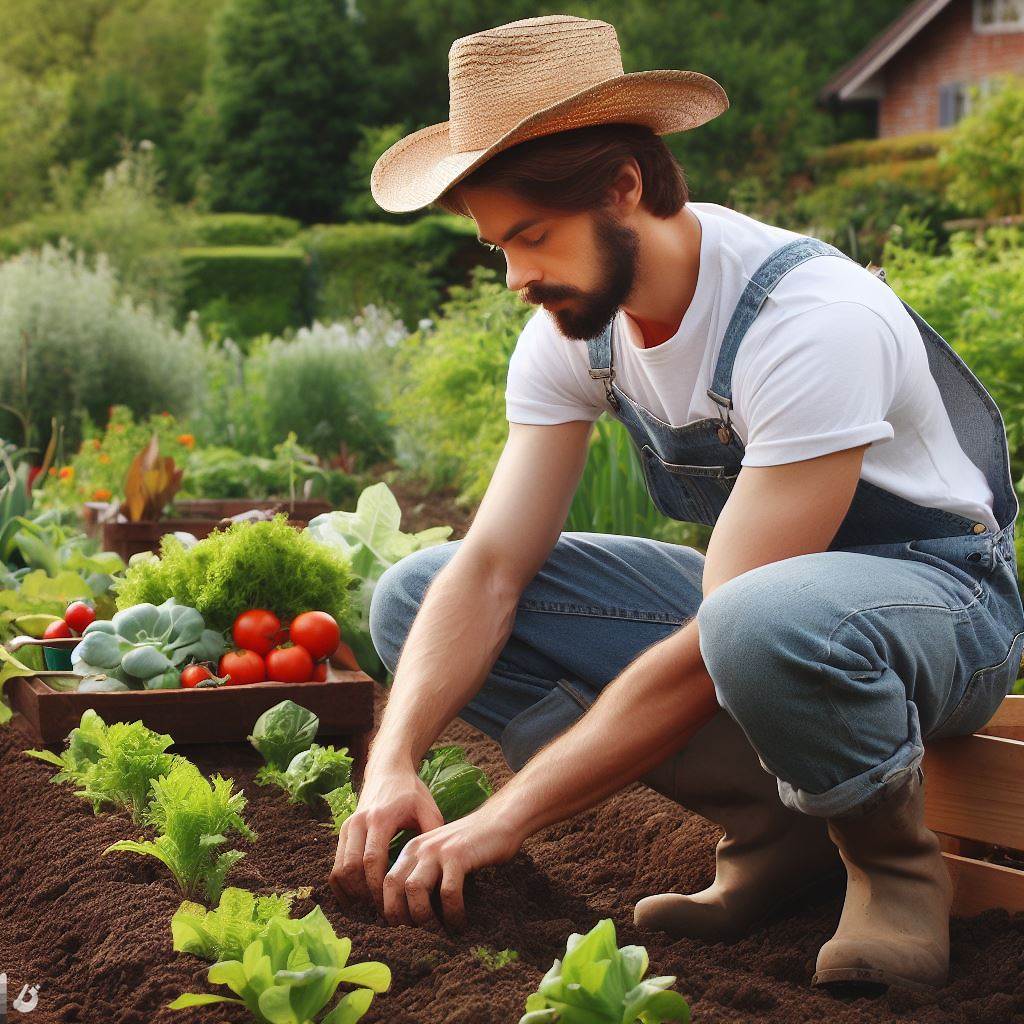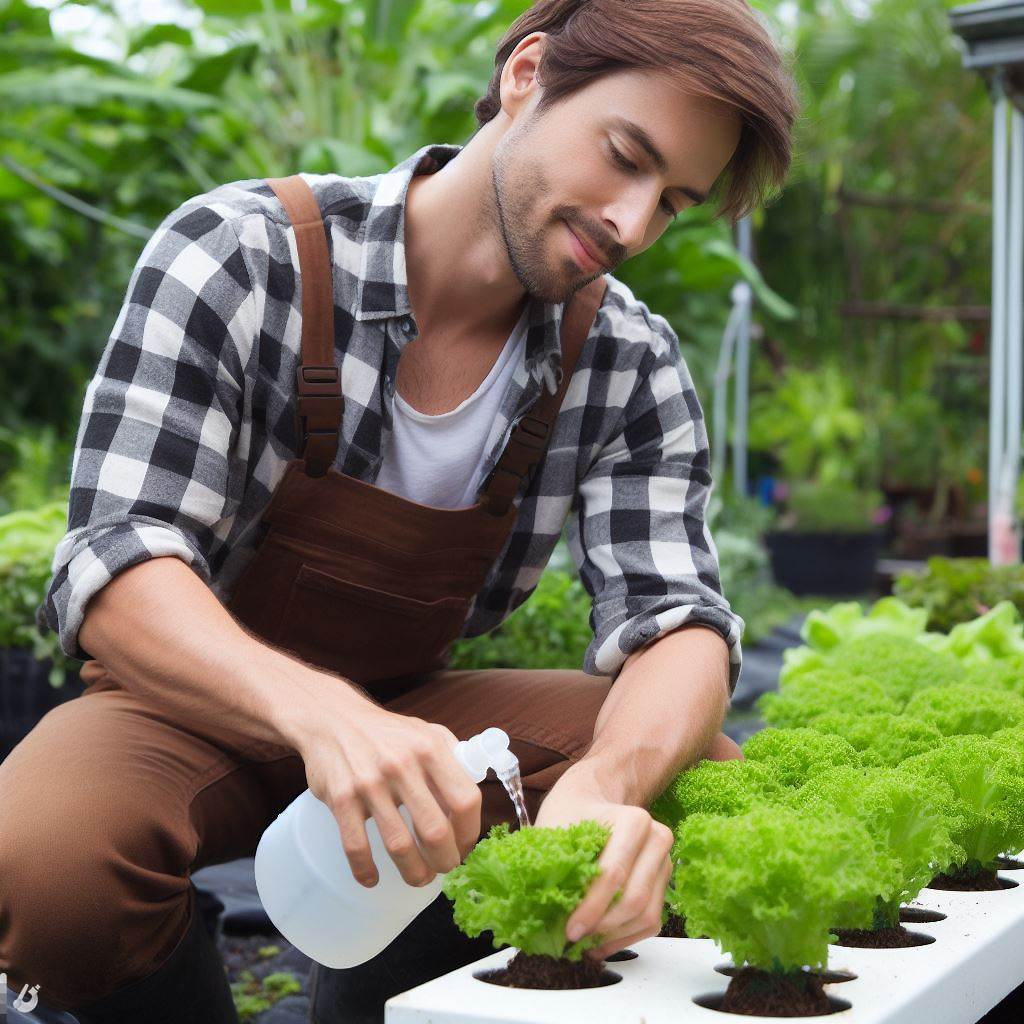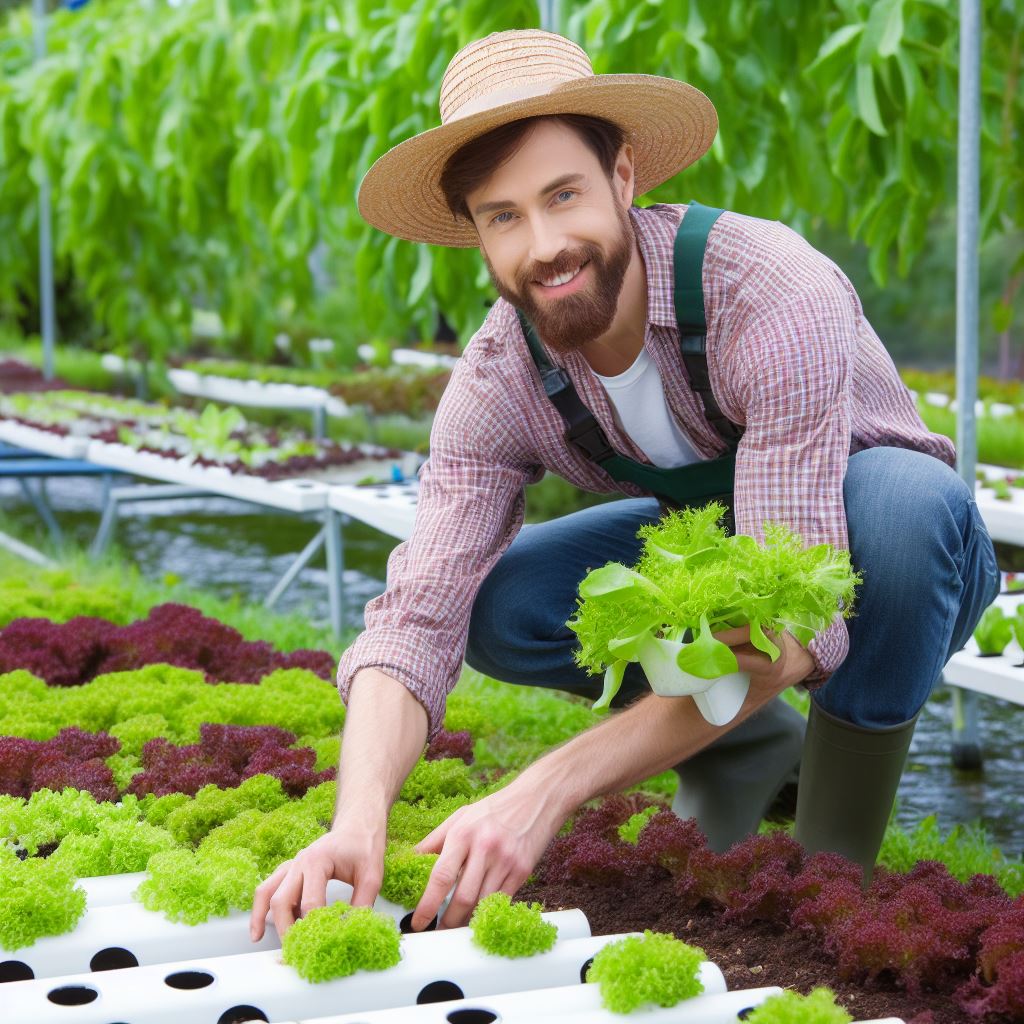Introduction
In small-scale farming, the key is to make the most out of limited space.
By implementing effective strategies, farmers can optimize their productivity and yield.
This section will delve into the different approaches and techniques that can be used to maximize space in small-scale farming.
One important strategy is vertical gardening.
By utilizing vertical space, farmers can grow more plants without expanding the actual ground area. This can be achieved through the use of trellises, hanging baskets, or vertical towers.
Vertical gardening allows for the cultivation of a wide range of crops, including vine vegetables and herbs.
Another method is intercropping, which involves planting different types of crops in close proximity.
This approach not only maximizes space but also promotes biodiversity and reduces the risk of pest infestation.
For example, interplanting corn and beans can enhance nutrient absorption and provide natural support for the climbing beans.
Furthermore, utilizing raised beds can be highly beneficial in small-scale farming.
Raised beds provide better drainage, deeper root penetration, and efficient space allocation.
Additionally, they offer the advantage of easier weed control and increased warmth for early planting.
In short, maximizing space in small-scale farming is vital for ensuring optimal productivity and yield.
By employing strategies such as vertical gardening, intercropping, and raised beds, farmers can make the most out of their limited land.
These methods not only help increase efficiency but also contribute to sustainable farming practices.
Transform Your Agribusiness
Unlock your farm's potential with expert advice tailored to your needs. Get actionable steps that drive real results.
Get StartedUtilizing Vertical Space
Benefits of Vertical Gardening in Small-Scale Farming
- Maximizes limited space by utilizing vertical structures for planting.
- Increases overall yield as more plants can be grown in the same area.
- Reduces the need for large expanses of land, making it suitable for urban areas.
- Enhances aesthetics as vertical gardens can add a beautiful and vibrant touch to any space.
- Provides better air circulation, leading to healthier plants and reduced chances of diseases.
Different Methods of Vertical Gardening
- Trellises: Install a sturdy trellis system that plants can climb upwards, saving horizontal space.
- Vertical Planters: Use stackable planters or hanging pots to grow plants vertically, utilizing wall or fence space.
- Wall-Mounted Containers: Attach containers to walls or fences, allowing plants to grow upwards.
- Pallet Gardens: Convert old pallets into vertical gardening systems, providing multiple planting levels.
- Tower Gardens: Utilize vertical tower systems that allow for numerous plants to be grown in a small footprint.
Tips for Successful Vertical Gardening in a Limited Space
- Choose the right plants: Select crops that are suitable for vertical growth, such as beans, tomatoes, and cucumbers.
- Consider sunlight exposure: Place vertical structures in areas with sufficient sunlight for optimal plant growth.
- Use lightweight materials: Opt for lightweight materials when constructing trellises or planters to avoid excessive stress on surfaces.
- Provide proper support: Ensure that the vertical structures are sturdy and can support the weight of the growing plants.
- Regular maintenance: Regularly prune plants to promote their upward growth and prevent overcrowding.
- Watering and fertilizing: Properly water and fertilize plants, ensuring that the vertical structure allows for easy access.
- Utilize companion planting: Pair compatible plants together to maximize the use of space and enhance growth.
- Install drip irrigation: Consider installing a drip irrigation system to efficiently provide water to plants without wasting it.
- Vertical training: Train plants while they are growing to follow the vertical structure and prevent entanglement.
- Pest control: Monitor for pests regularly and take necessary steps to prevent infestations, such as using organic pest control methods.
Vertical gardening in small-scale farming offers a multitude of benefits, making it an effective solution for maximizing limited space.
By understanding different methods and practicing proper techniques, anyone can create a successful vertical garden in their small-scale farming endeavors.
Companion Planting
Define companion planting and its advantages in small-scale farming
Companion planting is the practice of growing different plants together to enhance their growth and health.
It offers several advantages in small-scale farming, such as pest control and improved nutrient uptake.
By planting certain combinations, you can deter pests or attract beneficial insects, leading to better crop yields.
Furthermore, companion planting maximizes space utilization, as different plants can be grown side by side.
Different compatible plant combinations and their benefits
- Tomatoes and basil: Planting basil near tomatoes helps repel insects like flies and mosquitoes. Basil also enhances the flavor of tomatoes when used together in cooking.
- Carrots and onions: Carrots and onions complement each other in terms of nutrient requirements. Onions help deter carrot flies, while carrots help repel onion flies. Companion planting improves yields for both crops.
- Beans and corn: Growing beans and corn together provides mutual benefits. Beans fix nitrogen in the soil, which benefits corn, while corn provides a vertical support for climbing beans.
- Marigolds and tomatoes: Marigolds emit a strong fragrance that deters pests like nematodes. Planting marigolds around tomato plants helps protect them from these harmful pests.
- Cucumbers and radishes: Radishes act as a natural repellent against cucumber beetles. Interplanting radishes with cucumbers helps control the spread of these pests and improves cucumber growth.
The importance of crop rotation in maximizing space and maintaining soil health
Crop rotation is essential for small-scale farming as it prevents the buildup of pests and diseases in the soil.
By rotating crops, you can disrupt pest life cycles and reduce the risk of soil-borne diseases.
Different plants have varying nutrient requirements, and crop rotation ensures balanced nutrient utilization.
Additionally, crop rotation maximizes space by allowing you to grow different crops successively in the same area.
This practice also helps maintain soil health by preventing nutrient depletion and improving soil structure.
Benefits of crop rotation include:
- Pest management: Rotating crops reduces the population of specific pests that target certain plants. It disrupts their life cycle and prevents them from becoming established.
- Disease prevention: Rotating crops helps break disease cycles as some diseases are specific to particular plant families. This reduces the risk of pathogens becoming established and spreading in the soil.
- Nutrient management: Different plants have different nutrient requirements. Crop rotation ensures that the soil’s nutrient levels remain balanced and avoids depletion of specific nutrients.
- Weed control: Crop rotation can help reduce weed populations. Certain crops naturally suppress weed growth, making it easier to manage weed infestations.
In essence, companion planting offers numerous advantages for small-scale farming.
By strategically combining plants, you can promote pest control, enhance nutrient uptake, and maximize space utilization.
Crop rotation further contributes to successful small-scale farming by preventing pests and diseases,
maintaining soil health, and managing nutrients effectively.
These practices can lead to more sustainable and productive farming outcomes.
Read: Urban Farming 101: Starting Your City Garden
Intensive Planting Techniques
The concept of intensive planting and its relevance to small-scale farming
The concept of intensive planting is essential for maximizing space in small-scale farming.
Various techniques such as square foot gardening, intercropping, and succession planting
Various techniques can be employed, such as square foot gardening, intercropping, and succession planting.
Guidelines for implementing intensive planting techniques effectively
Implementing intensive planting effectively requires following these guidelines:
Square Foot Gardening
- Divide the growing area into small square sections for efficient use of space.
- Plant different crops in each square foot, considering their compatibility and growth patterns.
- Regularly maintain and weed the squares to ensure proper growth and maximum productivity.
Intercropping
- Planting complementary crops together, utilizing space between rows or within raised beds.
- Consider the height, growth rate, and nutrient requirements of the intercropped plants to avoid competition.
- Interplanting with nitrogen-fixing plants can provide a natural fertilizer source for other crops.
Succession Planting
- Continuously sow and replant crops throughout the season to maximize yield and extend harvest time.
- Start new seedlings indoors to have a ready supply for replacing harvested plants.
- Use quick-maturing varieties to ensure a continuous crop cycle.
Proper Spacing
- Follow recommended spacing guidelines for each crop to avoid overcrowding and competition for resources.
- Take into account plant height and spread, and adjust spacing accordingly.
- Utilize vertical gardening techniques, such as trellises and stakes, to save horizontal space.
Intensive Bed Management
- Practice regular bed preparation, including soil amendment, turning, and removal of debris.
- Utilize mulching to suppress weeds and conserve moisture, promoting healthy growth.
- Rotate crops annually to prevent soil depletion and minimize disease and pest issues.
Efficient Watering
- Utilize drip irrigation systems or soak hoses to provide targeted water delivery to plant roots.
- Install rainwater harvesting systems to reduce reliance on external water sources.
- Group plants with similar watering needs to avoid over or under-watering.
Continuous Monitoring
- Regularly inspect plants for signs of diseases, pests, or nutrient deficiencies for prompt action.
- Implement organic pest control methods, such as companion planting and beneficial insect attraction.
- Harvest crops at their peak to prevent wasted space and resources.
By implementing these intensive planting techniques, small-scale farmers can maximize their space and achieve higher yields and productivity.
Read: Organic Farming: Basics for Small Plots

Utilizing Containers and Raised Beds
Utilizing containers and raised beds significantly enhances the productivity and efficiency of small-scale farming.
By utilizing vertical space, small areas can accommodate a diverse range of plants, enhancing overall yields.
Showcase Your Farming Business
Publish your professional farming services profile on our blog for a one-time fee of $200 and reach a dedicated audience of farmers and agribusiness owners.
Publish Your ProfileUsing containers and raised beds also offers several advantages:
Enhanced Space Utilization
Containers and raised beds enable small-scale farmers to make the most of limited space.
By growing plants vertically, such as using hanging baskets or trellises for climbing plants, farmers can cultivate more varieties and increase overall production.
Improved Soil Quality and Drainage
Containers allow farmers to have better control over the quality and composition of the soil.
They can choose the appropriate potting mix based on each plant’s specific needs.
Containers with drainage holes prevent waterlogging, ensuring optimal soil moisture levels for the plants.
Convenient Maintenance and Harvest
Gardening in containers and raised beds provide easy access to plants, reducing the strain on the farmer’s back and knees.
It simplifies maintenance tasks, such as watering, weeding, and pest control.
Harvesting becomes more manageable as well, without the need to bend excessively or search through sprawling plants.
Flexibility and Mobility
Containers offer great flexibility as they can be easily moved according to sunlight and weather conditions.
This ensures plants receive the required amount of light each day for healthy growth.
Mobile containers allow farmers to protect certain plants from adverse weather or relocate them for visual purposes.
Variety of Containers for Different Plants
Various containers are suitable for different types of plants, each with its advantages:
- Clay pots are perfect for plants that prefer a well-draining and breathable environment.
- Plastic pots retain moisture and are lightweight and affordable.
- Fabric pots promote healthy root development by allowing proper aeration and drainage.
- Hanging baskets are ideal for trailing plants or those with vines, adding visual appeal to small spaces.
Tips for Successful Container Gardening
To maximize the benefits of container gardening and raised bed construction, consider the following tips:
- Choose a well-draining potting mix that suits the specific requirements of the plants being grown.
- Ensure containers have drainage holes to prevent water accumulation and root rot.
- Match the size of the container to the plant’s root system to provide enough room for growth.
- Implement companion planting to optimize space usage and naturally deter pests.
- Provide adequate sunlight, water, and nutrients according to each plant’s needs.
- Monitor moisture levels regularly and adjust watering accordingly to prevent over or under-watering.
- Utilize trellises, stakes, or other support structures to accommodate climbing and vining plants.
Tips for Successful Raised Bed Construction
When constructing raised beds, keep the following recommendations in mind:
- Use high-quality soil and amend it annually with compost or organic matter for fertility.
- Place raised beds in areas that receive ample sunlight and are easily accessible for maintenance.
- Opt for raised beds with suitable heights to prevent back strain during gardening activities.
- Space plants adequately within the raised beds to allow proper airflow and reduce disease risk.
- Rotate crops annually to prevent soil depletion and reduce the likelihood of pests and diseases.
By utilizing containers and raised beds effectively, small-scale farmers can overcome space limitations and maximize their agricultural potential.
Whether on balconies, rooftops, or small land plots, these techniques offer a practical solution for achieving a successful small-scale farm.
Read: Water Scarcity in Farming: A Growing Concern
Harnessing Microclimates
Understanding Microclimates and Their Significance in Small-Scale Farming
Microclimates refer to the unique weather conditions present within a limited space, such as a backyard or rooftop.
Small-scale farmers can benefit greatly from understanding and harnessing microclimates.
Factors to Consider for Utilizing Microclimates
Several factors play a crucial role in determining microclimates and should be taken into account when planning small-scale farming strategies:
- Sunlight: Assess the amount and intensity of sunlight received at different areas of your farm. Consider both direct and indirect sunlight.
- Wind: Determine the wind patterns in your farming space. Identify areas prone to heavy gusts and areas that are well-sheltered.
- Temperature: Measure temperature variations within your farm. Note areas that experience extreme heat or cold, as well as those with stable temperatures.
Strategic Approaches to Maximize Space Using Microclimates
To make the most of microclimates for small-scale farming, consider the following strategies:
- Zoning: Divide your farming space into different zones based on the microclimates present. By grouping plants with similar climate preferences together, you can optimize their growth and yield.
- Sun-loving Crops: Identify the sunniest spots in your farm and reserve them for crops that thrive in full sun. These areas are ideal for growing vegetables, herbs, and fruits that require maximum sunlight exposure.
- Shade-tolerant Crops: Utilize areas that receive less sunlight for shade-tolerant crops such as leafy greens, certain herbs, and root vegetables. These plants can benefit from partial sun or shade during the hottest part of the day.
- Windbreaks: Consider planting windbreaks, like tall trees or shrubs, in areas exposed to strong winds. These windbreaks will create microclimates that protect delicate crops from wind damage.
- Cold Frames and Greenhouses: Extend your growing season by utilizing cold frames and greenhouses in colder microclimates. These protected environments offer controlled temperature and humidity levels, allowing you to grow crops year-round.
- Microclimate Modification: Take advantage of microclimate modification techniques such as mulching, hardscaping, and reflective surfaces. Mulching retains heat and moisture, while hardscaping elements like stone walls absorb and radiate warmth.
Reflective surfaces, such as mirrors or foil, redirect sunlight to shaded areas. - Water Management: Consider microclimate-specific irrigation practices to ensure adequate water supply. Areas prone to high temperatures may require more frequent watering, while areas with excessive moisture may need efficient drainage systems.
- Seasonal Planting: Leverage microclimate variations throughout the seasons by adjusting your crop choices accordingly. For example, plant early-season crops in warmer microclimates and reserve colder microclimates for late-season or cold-hardy crops.
Remember, each microclimate on your farm provides a unique opportunity for maximizing space and optimizing crop productivity.
By understanding these microclimates and implementing suitable strategies, small-scale farmers can create thriving and diverse agricultural systems.
Read: Gardening Tools: Must-Haves for Beginners
Making Use of Vertical Structures and Supports
The importance of utilizing vertical structures and supports for plant growth
One important aspect of maximizing space in small-scale farming is utilizing vertical structures and supports for plant growth.
Types of supports (e.g., trellises, cages) and their advantages
There are various types of supports that can be used, such as trellises and cages, each with their own advantages:
- Trellises: Trellises are vertical structures made of wood, metal wires, or bamboo, and they provide support for climbing plants.
- Cages: Cages are typically made of wire mesh and are used to support plants that need to be contained and protected.
Tips for selecting and implementing vertical structures and supports in small-scale farming
Here are some tips for selecting and implementing vertical structures and supports in small-scale farming:
- Assess your plants’ needs: Determine the type of support that will best suit the plants you are growing.
- Consider the space available: Measure the available space and select structures that can fit within your limited area.
- Choose sturdy materials: Opt for materials that can withstand the weight of the plants and any adverse weather conditions.
- Ensure proper anchoring: Secure the structures firmly in the ground or to walls to prevent them from toppling over.
- Adjustability and flexibility: Select supports that can be adjusted or expanded as your plants grow.
- Maximize sunlight exposure: Position your structures to maximize sunlight exposure for optimal plant growth.
- Train your plants: Train the plants to grow along the structures by gently tying or attaching them using plant ties or wires.
- Regular maintenance: Regularly inspect and maintain your structures to ensure they remain in good condition and provide adequate support.
Utilizing vertical structures and supports in small-scale farming offers several benefits
- Space optimization: Vertical gardening allows you to grow more plants in a limited area, maximizing your space.
- Better air circulation: Plants grown on supports have improved air circulation, reducing the risk of diseases and pests.
- Easier harvesting: Vertical structures make it easier to access and harvest plants without the need to bend or stoop.
- Reduced plant diseases: Elevating plants using supports helps prevent soil-borne diseases and pests.
- Visual appeal: Vertical gardens can enhance the aesthetic appeal of your small-scale farm, creating an inviting and beautiful environment.
All in all, incorporating vertical structures and supports into your small-scale farming practices can greatly maximize your space and yield.
By carefully selecting and implementing these supports, you can create an efficient and productive farming system while enhancing the visual appeal of your farm.
Enjoy the benefits of vertical gardening and watch your plants flourish!
Conclusion
In this blog post, we discussed several key points for maximizing space in small-scale farming.
In this journey through small-scale farming, we unearthed key strategies: vertical gardening, companion planting, and space-efficient crop choices.
It is crucial to understand the importance of utilizing every inch of available land efficiently.
Maximizing space isn’t just a tactic; it’s a necessity for small-scale farmers aiming for productivity and sustainability.
Take charge of your small plot! Implement these strategies to cultivate abundance, fostering resilience and yield in your farming venture.
Whether you’re a novice or seasoned farmer, the spatial constraints of small-scale farming can be transformed into opportunities.
Embrace innovation, utilize every inch, and witness your small plot flourish. It’s not just about growing crops; it’s about cultivating a sustainable future.
Apply these strategies, sow the seeds of success, and let your small-scale farming endeavor thrive!
By implementing the strategies mentioned, readers can optimize their own small-scale farming endeavors.
Showcase Your Farming Business
Publish your professional farming services profile on our blog for a one-time fee of $200 and reach a dedicated audience of farmers and agribusiness owners.
Publish Your Profile



